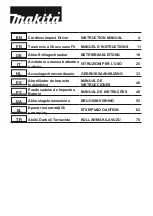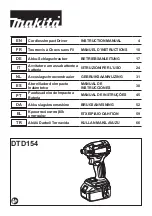
8
General Hints for Drilling in all Materials
• Always use sharp drill bits.
• Mark the place where you would like the hole to be drilled.
• Commence with a slow rotation speed to start the hole.
• Reduce your pressure on the tool when the drill bit is about to break through the material.
Metal Drilling
• Support thin material with a wooden plate.
• Use a punch to mark the position of the hole.
• If drilling a large hole use a small drill at first to establish a pilot hole then use the required
large size drill bit.
• Use only HSS (high speed steel) drill bits or those recommended for metal use.
• When drilling into iron or steel, use a cooling lubricant such as thin oil. With aluminium,
use turpentine or paraffin. With brass, copper and cast iron, use no lubricant but withdraw
the drill regularly to assist cooling.
Wood Drilling
• Mark the place where you want to drill with a punch or nail.
• To avoid splintering on breakthrough either clamp a piece of scrap wood to the back of the
wood or continue the hole from the back of the wood when the drill bit first breaks through.
Masonry Drilling
• Mark the place where you want to drill.
• Only use carbide tipped drill bits.
• Use the drill only in the forward position.
• Hold the drill firmly and place the bit at the point to be drilled.
• Do not force the drill. Allow the drill and the bit to do the work.
• If the bit jams in the work piece or stalls, stop the tool immediately. Remove the bit from
the work piece and determine the reason for jamming.
Summary of Contents for 331804
Page 11: ...10 DIAGRAM PARTS LIST IMPACT DRIVER ...
Page 13: ...12 DIAGRAM PARTS LIST CORDLESS DRILL ...
Page 15: ......

































